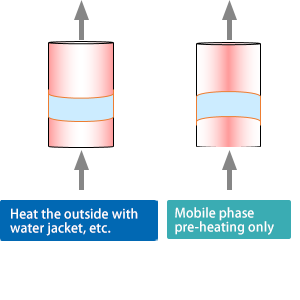
To develop preparative purification conditions, the first stage is to study the separation on the analytical scale. Columns should be selected taking into account availability of preparative columns/packing materials and costs for later scale up to the preparative separation. The post-column sample treatment should also be taken into account when selecting the separation conditions.
The following points should be considered for the selection of an appropriate separation mode.
For the preparative separation, it is important to separate the target compounds efficiently with high purity and high recovery rate.

It is recommended to use analytical-scale columns for mobile phase screening. Consideration of loading amount and efficiency on the post-column sample treatment should also be taken into account for preparative separation.
With isocratic elution, recycling preparation is possible. In addition, there is no need for reequilibration between sample injections during repeat preparative separations. With gradient elution, preparative fraction volumes can be expected to be smaller because peak widths will be narrower than those for an isocratic elution.
Comparison between isocratic elution and gradient elution

| Column | YMC-Pack C4 (5 µm, 300 Å) 250 X 4.6 mmI.D. |
|---|---|
| Eluent | A) water/TFA (100/0.1) B) acetonitrile/TFA (100/0.085) |
| Temperature | 40ºC |
| Detection | UV at 214 nm |
Post-column treatment is easier if volatile additives are used to control mobile phase pH
Generally, column temperature is controlled with a column oven for analytical separation, therefore, it is preferable for preparative separations to be performed under room temperature. It is not recommended to conduct preparative separations under other than room temperature because it is difficult to keep the internal column temperature constant across the column with a large inner diameter even with a large-scale temperature controlling device. Non-uniform internal temperatures lead to poor peak shape or peak splitting due to uneven flow of the sample. Therefore, it is important to check the temperature dependence of the resolution and peak shape on an analytical scale and to choose separation conditions at room temperature wherever possible for efficient preparative separations.
